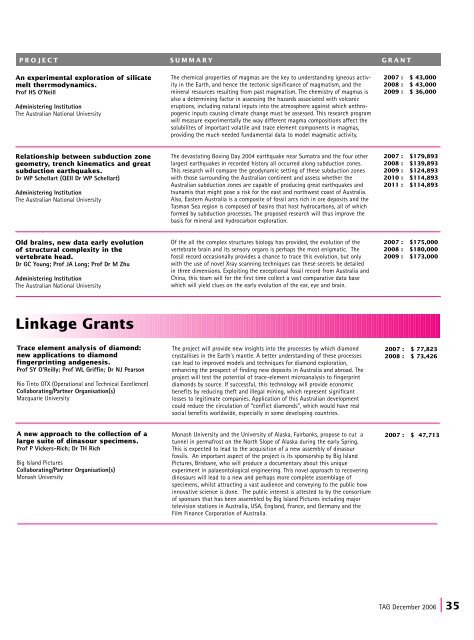The Australian Geologist - Geological Society of Australia
The Australian Geologist - Geological Society of Australia
The Australian Geologist - Geological Society of Australia
Create successful ePaper yourself
Turn your PDF publications into a flip-book with our unique Google optimized e-Paper software.
PROJECT SUMMARY GRANT<br />
An experimental exploration <strong>of</strong> silicate<br />
melt therrmodynamics.<br />
Pr<strong>of</strong> HS O'Neill<br />
Administering Institution<br />
<strong>The</strong> <strong><strong>Australia</strong>n</strong> National University<br />
<strong>The</strong> chemical properties <strong>of</strong> magmas are the key to understanding igneous activity<br />
in the Earth, and hence the tectonic significance <strong>of</strong> magmatism, and the<br />
mineral resources resulting from past magmatism. <strong>The</strong> chemistry <strong>of</strong> magmas is<br />
also a determining factor in assessing the hazards associated with volcanic<br />
eruptions, including natural inputs into the atmosphere against which anthropogenic<br />
inputs causing climate change must be assessed. This research program<br />
will measure experimentally the way different magma compositions affect the<br />
solubilites <strong>of</strong> important volatile and trace element components in magmas,<br />
providing the much needed fundamental data to model magmatic activity.<br />
2007 : $ 43,000<br />
2008 : $ 43,000<br />
2009 : $ 36,000<br />
Relationship between subduction zone<br />
geometry, trench kinematics and great<br />
subduction earthquakes.<br />
Dr WP Schellart (QEII Dr WP Schellart)<br />
Administering Institution<br />
<strong>The</strong> <strong><strong>Australia</strong>n</strong> National University<br />
<strong>The</strong> devastating Boxing Day 2004 earthquake near Sumatra and the four other<br />
largest earthquakes in recorded history all occurred along subduction zones.<br />
This research will compare the geodynamic setting <strong>of</strong> these subduction zones<br />
with those surrounding the <strong><strong>Australia</strong>n</strong> continent and assess whether the<br />
<strong><strong>Australia</strong>n</strong> subduction zones are capable <strong>of</strong> producing great earthquakes and<br />
tsunamis that might pose a risk for the east and northwest coast <strong>of</strong> <strong>Australia</strong>.<br />
Also, Eastern <strong>Australia</strong> is a composite <strong>of</strong> fossil arcs rich in ore deposits and the<br />
Tasman Sea region is composed <strong>of</strong> basins that host hydrocarbons, all <strong>of</strong> which<br />
formed by subduction processes. <strong>The</strong> proposed research will thus improve the<br />
basis for mineral and hydrocarbon exploration.<br />
2007 : $179,893<br />
2008 : $139,893<br />
2009 : $124,893<br />
2010 : $114,893<br />
2011 : $114,893<br />
Old brains, new data early evolution<br />
<strong>of</strong> structural complexity in the<br />
vertebrate head.<br />
Dr GC Young; Pr<strong>of</strong> JA Long; Pr<strong>of</strong> Dr M Zhu<br />
Administering Institution<br />
<strong>The</strong> <strong><strong>Australia</strong>n</strong> National University<br />
Of the all the complex structures biology has provided, the evolution <strong>of</strong> the<br />
vertebrate brain and its sensory organs is perhaps the most enigmatic. <strong>The</strong><br />
fossil record occasionally provides a chance to trace this evolution, but only<br />
with the use <strong>of</strong> novel Xray scanning techniques can these secrets be detailed<br />
in three dimensions. Exploiting the exceptional fossil record from <strong>Australia</strong> and<br />
China, this team will for the first time collect a vast comparative data base<br />
which will yield clues on the early evolution <strong>of</strong> the ear, eye and brain.<br />
2007 : $175,000<br />
2008 : $180,000<br />
2009 : $173,000<br />
Linkage Grants<br />
Trace element analysis <strong>of</strong> diamond:<br />
new applications to diamond<br />
fingerprinting andgenesis.<br />
Pr<strong>of</strong> SY O'Reilly; Pr<strong>of</strong> WL Griffin; Dr NJ Pearson<br />
Rio Tinto OTX (Operational and Technical Excellence)<br />
Collaborating/Partner Organisation(s)<br />
Macquarie University<br />
<strong>The</strong> project will provide new insights into the processes by which diamond<br />
crystallises in the Earth's mantle. A better understanding <strong>of</strong> these processes<br />
can lead to improved models and techniques for diamond exploration,<br />
enhancing the prospect <strong>of</strong> finding new deposits in <strong>Australia</strong> and abroad. <strong>The</strong><br />
project will test the potential <strong>of</strong> trace-element microanalysis to fingerprint<br />
diamonds by source. If successful, this technology will provide economic<br />
benefits by reducing theft and illegal mining, which represent significant<br />
losses to legitimate companies. Application <strong>of</strong> this <strong><strong>Australia</strong>n</strong> development<br />
could reduce the circulation <strong>of</strong> “conflict diamonds”, which would have real<br />
social benefits worldwide, especially in some developing countries.<br />
2007 : $ 77,823<br />
2008 : $ 73,426<br />
A new approach to the collection <strong>of</strong> a<br />
large suite <strong>of</strong> dinasour specimens.<br />
Pr<strong>of</strong> P Vickers-Rich; Dr TH Rich<br />
Big Island Pictures<br />
Collaborating/Partner Organisation(s)<br />
Monash University<br />
Monash University and the University <strong>of</strong> Alaska, Fairbanks, propose to cut a<br />
tunnel in permafrost on the North Slope <strong>of</strong> Alaska during the early Spring.<br />
This is expected to lead to the acquisition <strong>of</strong> a new assembly <strong>of</strong> dinasour<br />
fossils. An important aspect <strong>of</strong> the project is its sponsorship by Big Island<br />
Pictures, Brisbane, who will produce a documentary about this unique<br />
experiment in palaeontological engineering. This novel approach to recovering<br />
dinosaurs will lead to a new and perhaps more complete assemblage <strong>of</strong><br />
specimens, whilst attracting a vast audience and conveying to the public how<br />
innovative science is done. <strong>The</strong> public interest is attested to by the consortium<br />
<strong>of</strong> sponsors that has been assembled by Big Island Pictures including major<br />
television stations in <strong>Australia</strong>, USA, England, France, and Germany and the<br />
Film Finance Corporation <strong>of</strong> <strong>Australia</strong>.<br />
2007 : $ 47,713<br />
TAG December 2006 | 35

















